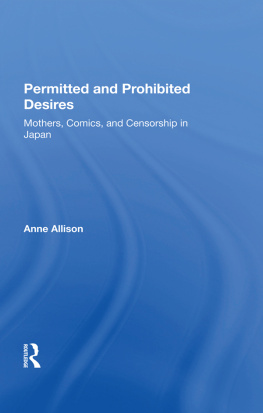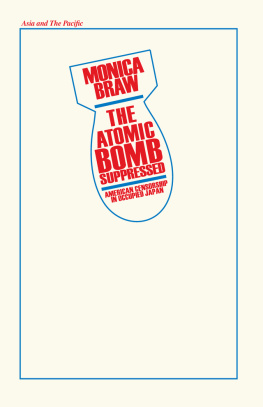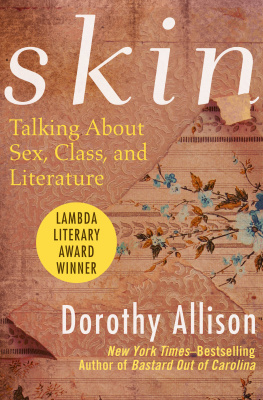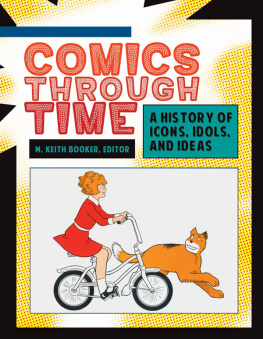Permitted and Prohibited Desires
First published 1996 by Westview Press
Published 2019 by Routledge
52 Vanderbilt Avenue, New York, NY 10017
2 Park Square, Milton Park, Abingdon, Oxon OX14 4RN
Routledge is an imprint of the Taylor & Francis Group, an informa business
Copyright 1996 Taylor & Francis
All rights reserved. No part of this book may be reprinted or reproduced or utilised in any form or by any electronic, mechanical, or other means, now known or hereafter invented, including photocopying and recording, or in any information storage or retrieval system, without permission in writing from the publishers.
Notice:
Product or corporate names may be trademarks or registered trademarks, and are used only for identification and explanation without intent to infringe.
A CIP catalog record for this book is available from the Library of Congress.
ISBN 13: 978-0-367-28263-9 (hbk)
In memory of Lawrence True Allison
There are a number of people who have variously supported and assisted me in this project. I would like to offer my appreciation to them all: Katherine Ewing, Marro Inoue, John Comaroff, Katherine Murawski, Jennifer Hirsch, Kristina Troost, Kren Wigen, Andrew Gordon, Eiji Yutani, John Soit, Greg Leupp, Naomi Quinn, Mack OBarr, William Kelly, Brett deBary, Harry Harootunian, Steve Snyder, Linda White, Susan Erikson, Sawa Becker, Miriam Silverberg, Margaret Lock, Arif Dirlik, Anne Imamura, Dennis McGilvray, Paul Shankman, Tani Barlow, Susan Napier, Lori Gruen, Jean OBarr, and Nancy Rosenberger. I would also like to thank people at Westview Press who have been tremendously helpful in the books production. Kellie Masterson, who subsequently left, first inspired me to do this project with Westview; Gordon Massman later became my editor; Connie Oehring has been project editor; and Diane Hess was an expert in copyediting.
Orin Starn has been a special colleague and friend, and for his constant input and support, I thank him deeply. My children, Adam and David, have lived through this project with me, from eating the obent I made for them in Japan to the long months enduring my distractions and moods while writing it here. Their enthusiasm for my work, despite its definite oddity, I appreciate tremendously.
It was my partner, Charlie Piot, who first suggested this book, and he has been tireless in offering assistance and encouragement of all kinds throughout its production. It is he who has wrapped its everyday labors within joys both profound and mundane. I have no words to express my feelings and thanks.
Lastly, I dedicate this book to my father, Lawrence True Allison, who lay dying as I started the last chapter (radically dissonant, even surreal. Yet, curiously, they never did, just as my prediction about the incomprehensibility of the book to my father was not borne out. Occasionally he would remark on what I had read, and always it concerned the same partstories about Schwarzkopfs childhood, particularly his mother.
Desires somehow emerge out of life, even the life of someone who is dying. And they involve realness as much as fantasy. I learned even more about this when I returned at the end of June to my home in Durham, which was empty; my sons were with their dad in New York and my partner with his daughter in Colorado. All alone, I worked on . And every night at 11 I called my father, who had moved to a hospice. As a result of new pain medication, my dad had become reenergized and reconnected somehow to the world. He also had rediscovered the taste for food, which gave him the delight of a new discovery. We had long, engaging conversations in which he would tell me the details of each meal, lingering over its pleasures and, sometimes, its disappointments. And he always asked about my work, wondering how the chapter was coming and encouraging me with his interest. By the end of the month, it was the desire to answer my fathers question about whether the chapter was done that inspired me to finish it.
I saw my dad again in August for the last time. The desires and grace with which he laced the last days of his life and which he was able to not only share with me but also connect to my work have left an indelible memory. I feel blessed to have this as well as a mother whose image of strength and beauty in the endless labors of love she extended to my father as he lay dying will inspire me forever.
Anne Allison
Desire is both of and beyond the everyday. In an ad for running shoes, for example, the figure of a man jogging at dawn on the Serengeti Plain both evokes a fantasy of escape and invokes a disciplinary norm to stay fit. The bottom line for the ad, of course, is to create a desire to consume, the promise being that with the purchase of these shoes, the consumer can realize yet also transcend the daily exhortation to perform.
To say this differently, there is something both real and phantasmic about desire. Yet this notion seems contradictory. Isnt there a difference between the desire to be fit, for example, which is realizable, realistic, and, in these senses, real and the desire to escape routine everydayness, which, for most of us, is inescapable most of the time? But is exercise real or phantasmic? Certainly not everyone works out, and even those who make exercise a part of their reality may do so in order to pursue a fantasy about themselves. And are escapes from daily routines phantasmic or real? An escape from the everyday is far more realizable for some people than even fitness. But here too what is fantasy blends into (and becomes indistinguishable from) the real: A vacation away from work may be a means of ensuring a higher level of work performance when one returns.
Looking back at the ad, we can see that the desires structured here reflect a certain perception and experience of the world: one that demands hard work, values high performance, and pleasurizes the foreignness of other worlds. It is in terms of this worldview that the desire to run hard is not so distinct from the desire to travel to the Serengeti Plain. One involves a daily workout, the other large sums of money acquired from years of saving or a high-powered job. Both are signs of hard work that, captured through desire, suggest both the realization of a fantasy and the phantasmal quality of the real.
* * *
My objective in this book is to contemplate how desire as something that segues both into and out of the realities of everyday life is configured through relations of production and consumption in late capitalist Japan. Specifically, I am interested in one domain of productivity: the home, where women, as mothers, have been major contributors, albeit indirectly, as Mary Brinton writes (1993), to the economic success story of postwar Japan. It has been the role of stay-at-home mothers (not a viable option for all families, of course) to oversee and therefore ensure the high performance of Japanese youth as they labor through the ranks of a highly regimented and competitive school system. In this educated and disciplined body of the child are rooted the labor force and consumer population of the Japanese state. In both cases, what is demanded is the production of an exceptionally competent society whose members work remarkably well but do not, should not, produce spectacle as individuals (Field 1995:26).
What children learn in Japanese schools is far more than the academic skills they are world-renowned for mastering. More important is an attitude toward work: a willingness to bend to the authority of the school system and an ability to mimetically reproduce its structure of endless surveillance, constant exams, and habitual memorization. As Foucault (1980) has written about the shift in western sexuality from something that once was a mere act to something now thought to constitute the very foundation of the true self, the postwar educational model in Japan exceeds being merely a school system and extends into a regime of test-taking that produces and centers the Japanese self. In what is called Japans gakureki shakai (academic-pedigree society), the schools one attends almost totally determine ones future career. In turn, admission into high school and college is determined by performance on entrance exams, the rigors and stakes of which are well known to even preschool-aged children. In the name of offering preparation for these tasks, a whole industry of supplemental trainingcram schools (juku) , preparation schools ( yobik), written guidebooks, and sample testshas built up since the 1960s and further encases children in work schedules that leave little time for anything else.







